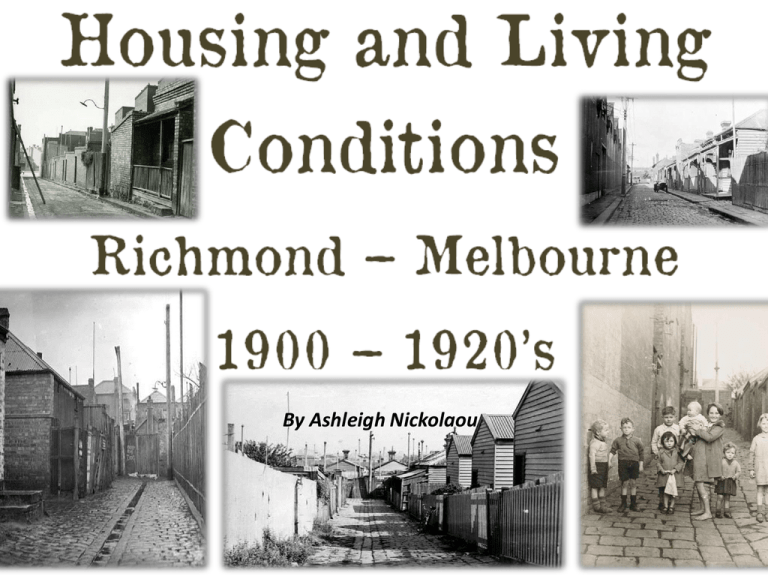housing and living condition
advertisement

By Ashleigh Nickolaou Housing – Poor (slums) Housing for the poor is dramatically different to housing for the rich. In the 1900 – 1920’s the positioning of your house practically showed your social status. The rich lived at the top of the hill were it was rarely flooded and away from factories pollution and the poor lived at the bottom of the hill in the ‘slums’ were they were regularly flooded and surrounded in pollution and diseases, the bottom of the hill was un sanitary and not safe and the houses were usually too small for those living in them. Houses were mostly prefabricated iron houses that were shipped from overseas. These houses were designed for people with near to no skills. Iron houses were extremely cold during the winter and extremely hot in the summer, however they provided somewhat adequate shelter for thousands. Families were squeezed into tiny houses near factories were they worked; people living in the slums generally struggled to pay rent and other necessities. When the world went through the industrial revolution factories and mass production was introduced, this meant that jobs were produced however resulted in pay being very low making it hard for families to pay for living expenses. Many houses provided shelter for more than 10 people, in houses that had only 2 rooms! Family sizes were extremely large due to the lack of contraceptives. All the above aspects made the quality of life low and also brought the house prices down dramatically. Housing - Rich Housing for the rich was much more sophisticated and sanitary than the slums. The rich lived at the top of the hill were churches and shops were situated. Houses were a lot less cramped and houses could be nearly triple the size of the poor housing. Living at the top of the hill was reserved for the rich. Rich houses had separate bedrooms for adults and children an inside kitchen, laundry, sitting rooms and bathroom and also a clean garden. The rich had a much less chance of catching diseases as houses were much more sanitary, and if they happened to become sick they could afford proper treatment. During the 1900 1920’s there was a massive separation between rich and poor, both leading completely separate lives. Family life and growing up Family life and growing up was very different to today. The average size of a family was very large and the poor were very cramped due to the size of their houses. Children didn’t have much time to be kids as when they reached the age of twelve they would work. The word ‘teenager’ didn’t exist as children didn’t have that transition from child to adult like we do today. When families could no longer send children to school they would send them to work or look after other siblings and the house. The lack of education and a sense of discipline often resulted in ending up in gangs and violence. Poor children attended local public schools until their parents couldn’t pay the fees and were expected to then work, in some cases children younger than seven had to work and provide and income. In the slums the children’s backyard was their alley way, this was very dirty and unsanitary, most children wouldn’t feel lonely as all the children in the community played together. Children made their own fun with things that didn’t require much equipment. On the contrary rich children could play in backyards however they were forbidden from playing with the poor in the streets. There gardens/backyards were away from the unsanitary surrounding and didn’t have to start working at such young ages, their houses weren’t cramped, they were more educated, and food was more abundant, families also had more time for leisure participating in sports typically reserved for the rich. Living conditions changed quite drastically compared to before the 1920’s meaning that youth’s were able to participate in new activities like listening to the radio and going to cinemas. Girls were able to have more freedom in their clothing choices, being able to show more skin, wear makeup and go to the beach with boys in their bathers. Public events became increasingly popular and rich and poor began to mix together more than ever, creating a much less visible barrier. Although times had changed girls were still less adventurous due to the stereotype placed upon them. Average Life Expectancy During the first decade of the 20th century the life expectancy was: Men = 55.2 Women = 58.4 These statistics show how the affects of low living quality can impact ones life expectancy Occupation Conditions The working life for the poor was considerably harder as many poor families did not have enough money for food and rent as the factories often didn’t pay well. This was the opposite for rich families as they didn’t have to work as hard for little pay. Women in the lower class would usually work at the factories however this was completely opposite for the higher classes. The rich and poor very rarely worked together and had completely different occupations. The rich would usually receive tertiary education enabling them to get higher class jobs such as doctors. The poor on the other hand wouldn’t get education higher than primary education and generally work in factories. The rich worked in town whereas the poor worked in the slums. For a long time there was no real contact between the rich and poor as they were forced to lead completely separate lives. Average weekly wage in 1901 for males: $4.35 for working almost 50 hours after inflation this equates to $217.50 This statistic shows the difficulty in affording just the daily essentials Bibliography • http://heritage.vic.gov.au/Heritage-placesobjects/What-house-is-that/index.html • http://richmond-livingconditions.blogspot.com.au/p/housing.html • http://www.walkingmelbourne.com/forum/viewtopic. php?f=23&t=1937&start=0 • http://museumvictoria.com.au/melbournemuseum/w hatson/current-exhibitions/melbournestory/exhibitionnotes/ • http://www.ignatius.org.au/RichmondsHistory.htm • http://richmond-living-conditions.blogspot.com.au/ Thankyou!




